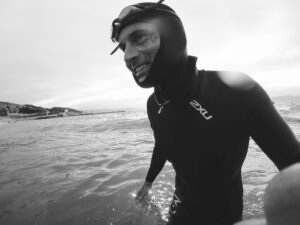The short answer is yes. (And in the following I will explain why.)
Low levels of exercise among people with post-traumatic stress disorder (PTSD) may explain why many with PTSD have been shown to be at high risk for a number of physical health problems, such as obesity, heart disease, pain and diabetes. There may be several reasons why people with PTSD are less likely to exercise. In this article, however, I will focus on what happens when people with PTSD use exercise as medicine
A review of four randomized controlled trials (RCTs) on the effect of regular exercise on PTSD found that physical activity significantly reduced depressive and PTSD symptoms. It suggested that more studies should be done on this relationship and concluded that including physical activity in the treatment of PTSD appears to be helpful. (Sources 1 and 2)
Table of content
- Why exercise improves (reduces) PTSD symptoms?
- How Does Exercise Improve PTSD?
- Which exercises are best for PTSD?
- Does running reduce PTSD symptoms?
- My personal training regimen
- What physical symptoms does PTSD give?
- Does exercise work for all ages of veterans?
- Conclusion.(Or how to recover from PTSD?)
- Sources.
Why exercise improves (reduces) PTSD symptoms
Whether you have PTSD or not, regular exercise has a number of benefits. It can contribute to many positive physical benefits, such as improved cardiovascular health, weight loss and greater flexibility and mobility. In addition to these physical benefits, regular exercise can also have a positive impact on your mental health by reducing anxiety and depression and increasing your chances of better sleep. Which is super important for PTSD.
How Does Exercise Improve PTSD?
Common therapeutic treatments for PTSD include exposure and desensitization to reduce the emotional strain caused by the trauma. During exercise, this happens automatically and will immediately result in improved cognitive function, exercise-induced neuroplasticity, normalization of hypothalamic pituitary axis (HPA) function and reductions in inflammatory markers.
In short, exercise is trauma treatment without the stigma that regular trauma treatment by a therapist entails.
Which exercises are best for PTSD?
Work out in a form that will give you the most pleasure possible. Whether it’s strength training in the gym, running, walking, cycling, team sports, even yoga or tai-chi, they all provide benefits for your mental health, including PTSD.
Speaking of my own experience, I have found that running has helped me a lot with my PTSD. The reason is not running alone, but the simple form of running. This means that the threshold for exercising (running) is so low that it can almost always be combined with a life with the PTSD diagnosis.
How does PTSD affect you physically?
In addition to the thoughts and people with PTSD may also experience physical symptoms, such as increased blood pressure and heart rate, fatigue, muscle tension, nausea, joint pain, headaches, back pain or other types of pain.
Does running reduce PTSD symptoms?
Again, the short answer is Yes.
Based on previous studies in animals, the researchers theorized that running would help increase the levels of a brain protein called brain-derived neurotrophic factor, or BDNF.
The protein helps the brain adapt to stress factors and repair itself, and it is low in people with PTSD. It is also involved in learning and memory, and previous studies – again, on animals – have shown that it plays a role in reducing fear. In other words, it helps the brain to establish context, and therefore a sense of security, around dreaded signals. So, for example, when you hear a big bang on the fourth of July, you know it’s a firework and not a bomb. Source 3


My personal training regimen.
I have had PTSD for more than 30 years. My way of dealing with the diagnosis has been different at different stages of life.
I have self-medicated myself, (not with alcohol and other drugs,) but with activity. This is quite common.
Some work too hard to wear themselves out, some work with a stress level that gives them a feeling that the world outside their heads is as busy as the war scenario they have inside their head. And thus it seems as if the world is «normal».
My personal handling of this was for many years, too much activity. Activity in the form of work, studying and various extreme hobbies. Of course, this does not sound like a negative thing, but it can be, when it is done too much. As a young man / woman, you cope with 12 hours of work, little sleep, a lot of training and expected socialization that others normally have, for a period of time, but then you get tired. Especially if you initially have PTSD. The famous candle is really burned at both ends.
I noticed this especially at the age of thirty and beyond. In addition, I had children, which we all know requires extra effort. (If you are interested you can read more about my personal story here.)
I started looking for activities that allowed me to get tired, but in a healthy way. Activities that gave me refills without draining me of energy. I have always trained a lot and it has helped me stay healthy. As I got older, I noticed that exercise also kept me healthier in my head and actually helped me keep the worst PTSD symptoms away.
The form of training I did the most was running. This is due to practical reasons. (I live in a country that has unique opportunities for running and the form of exercise has made it easy to get out of the house.) Studies also show that running is a good activity to do when you have PTSD. But I have trained other things as well. My daughter, (who do not have PTSD, but are young and like to exercise), often take her father out for exercise. I have at times been swimming (in the sea), and regularly used weight training in addition to running.
As one get older, it is important to emphasize weight training. Simply because an older person need extra muscle building. (We lose one percentage of muscle strength every year from the age of 30.) I will not write about my training regimen in detail here, (I will address this in another post.) I just wanted to focus on the fact that training, and with emphasis on running totally changed my life in a better direction.
PTSD symptomatology has become extremely less intrusive and the ability to function as a “normal” person has never been greater. Exercise for me is pure PTSD medicine and of course much healthier than any other medicine.
What physical symptoms does PTSD give?
Although PTSD is a psychological health diagnosis, it can have a profound impact on both physical health and social health factors as well. Every individual that is diagnosed with PTSD will have a different story, however it is common that there are also signs of reduced physical health, social inclusion and of course, psychological health. Some of many symptoms include:
PHYSICALLY
- Weight fluctuations (weight gain or loss)
- Increased blood pressure
- Increased sedentary behaviours
- Higher risk of diabetes
SOCIALLY
- Increased time spent at home
- Avoid catching up with family and friends
- Avoidance of busy or noise stimulating areas
- Increased time spent away from work
PSYCHOLOGICALLY
- Increased anxiety
- Depressed mood
- Poor sleep hygiene due to night terrors
- Increased fear/avoidance associated with certain triggers
Does exercise work for all ages of veterans?
Again, yes it does.
This is an excerpt from a pilot Randomized Controlled Trial of Exercise Training for Older Veterans with PTSD, which I reproduce. I will attach the link to the study at the end of this article..
“The results of this pilot study contribute to a small, but growing, literature which suggests that exercise training is an acceptable intervention among individuals with PTSD, and improves PTSD symptoms and PTSD-related health outcomes, which is exciting. These findings are important for they show impact of exercise training on important clinical and patient-reported outcomes.
As with traditional PTSD treatments, clinical symptoms of PTSD were still evident at the end of the intervention period. However, exercise training represents an empowering therapy that allows an individual to better their health and functioning in the context of a chronic mental health condition. Exercise in, and for, PTSD is a relatively new area of study.
Many questions remain to be explored in future work including efficacy trials, studies that evaluate mechanistic factors (e.g., exercise capacity, sleep) as mediators of the improvement in PTSD symptoms, sub-group analyses, and implementation approaches to improve the health and well-being of individuals living with PTSD.”
Conclusion
Running exercise is an affordable, widely available activity known to provide several health benefits, including cardiovascular health and musculoskeletal health, as well as reduced incidence of comorbidity and mortality. In addition, running is not associated with the stigma of standard mental health care.
There is growing evidence of the beneficial effects of exercise on mental disorders, including depression and anxiety. It is not a given that everyone can start running. Obesity, general physical fitness can make this impossible. Therefore, start with the first small (literally) step. Take a tour in your neighborhood.
Ten minutes every night. (or every morning) Increase gradually. Buy a good pair of shoes and make the trips a little longer eventually. If you want to jog a little, the better it is. But the most important thing is to start an activity that causes the body to move.
Before you know it, you are a runner. And a little less marked by the impact of PTSD.

What is a lifetime, really?
Twenty good years? A good friend of mine once said while walking in the mountains of Gran Canaria.“Knut, we have twenty good years left. Use

How to protect yourself from your PTSD, when the world is on fire
(It is war. And it is mine. ) The headlines that meet me today are about the war in Ukraine. Alarms going off, people fleeing,

The thin film of civilization
The thin film of civilization This picture are taken on Lesvos. Her husband and baby drowned on the way over from Turkey. This is a
